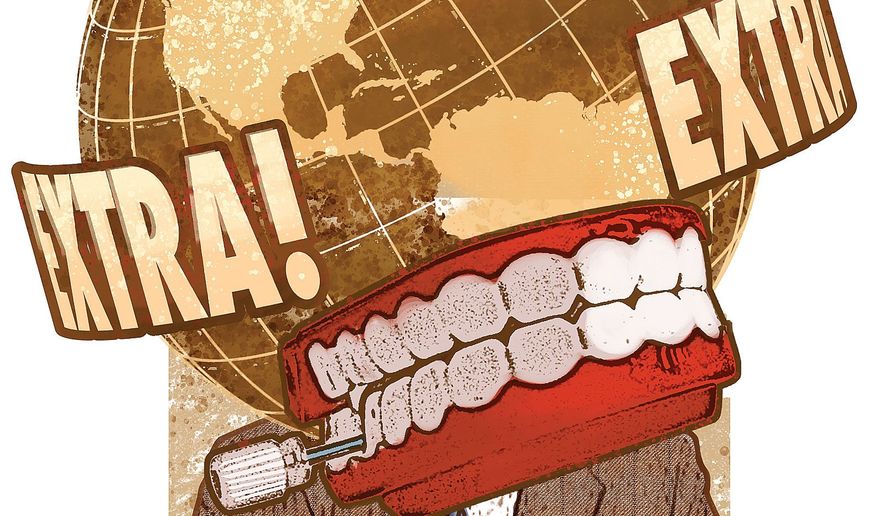OPINION:
Scurrilous and “fake” news has been around since the penny tabloids of an earlier era when politicians actually subsidized newspapers and paid journalists to spread lies about their opponents to what they hoped was a credulous public. Thomas Jefferson famously employed James Callendar to spread fake news about John Adams as the two fought for the White House in 1800, describing him as essentially an agent of the British intent upon fomenting war with France. Adams’ forces retaliated, claiming Jefferson supported the French terror and routinely cheated his creditors.
This sort of “fake” news, often spread by partisans, has plagued American politics ever since. In 1928, Protestant ministers appalled at the very idea that Catholic Al Smith might become president spread the word that if he was elected, there was a plan afoot to get the pope to move the Holy See to Washington and take over the government. Similarly, during the 1960 Democratic primary in Wisconsin pitting John F. Kennedy against Minnesota’s Hubert Humphrey, that state’s Catholics received a supposedly misdirected letter bearing a Minneapolis postmark alleging that Kennedy was “an agent of the Pope.” Outraged Catholics predictably rallied behind Kennedy who, it was later discovered, paid for the mailing.
Four years later, the media picked up and spread the “fake” news that Republican presidential candidate Barry Goldwater had secretly traveled to Germany to meet with proto-Nazis in that country. The reports bolstered the Democratic charge that Goldwater was a dangerous extremist, but had no basis in fact.
More recently, it is hard to forget Nevada Sen. Harry Reid standing on the Senate floor proclaiming that 2012 Republican presidential nominee Mitt Romney was a tax cheat and challenging him to disprove it, or the internet allegations that Barack Obama was born not in the United States, but in Kenya.
With the internet, fantasists, conspiracy buffs and dirty tricksters are having a field day and perhaps scrambling the brains of those who don’t bother to distinguish between the real and the fanciful. Much of what has been broadcast over the internet in the most recent presidential cycle emanated from the fever swamps of the left and right, and made no sense whatever. Some of it was apparently generated by partisans of the two candidates to sully the other or convince the unsuspecting that the other was the source of lies and should thus be condemned for his or her activities. The problem, of course, is that the anonymous poster of fake news is as difficult to unmask as the anonymous pamphleteers of earlier centuries.
This year was different in degree, however, and perhaps in kind. Both candidates tended to exaggerate. When Mr. Trump’s forces claimed millions of illegal votes may have been cast, his opponents countered by saying none had been cast and that illegal voting was not now nor had ever been a problem in this country. When somebody hacked into emails that proved embarrassing to Mrs. Clinton, her campaign blamed it on the Russians, alleging that her opponent was either an agent of Russian President Vladimir Putin or, as former Secretary of State Madeleine Albright put it, “a useful idiot” serving Mr. Putin’s purposes.
The allegations were bizarre in that the press picked them up and repeated them, forgetting the way rumors that left-wing Democrats in an earlier day were “soft” on Communism or actually in league with then-Soviet Russia were dismissed as a slanderous resort to McCarthyism. This year similar allegations were accepted and promoted by much of the media and many in Congress with nary a raised eyebrow. The Washington Post even reported and is now being sued for publicizing as fact an anonymous “investigative” report from something called PropOrNot, claiming more than 200 internet sites ranging from the Drudge Report on the right to Counterpunch and Truthdig on the left serve as propaganda conduits for Russian intelligence.
While it is true that some of the “false news” sites of concern are based either in Russia or Eastern Europe, it is unclear whether any were run or directed by the Putin regime; some at the CIA and elsewhere say they were while others, including many at the FBI, are far from certain that this is the case.
The upshot is that even as Mr. Trump prepares to move into the White House, many on the left — along with a few Republicans who believe his likely attempt to defuse the current U.S.-Russian standoff would be a mistake — are demanding an investigation to see what happened. It is unlikely that such an investigation will turn up any definitive proof that Moscow attempted to interfere in the election, even less that whatever went on had any real impact on the outcome. And it will uncover none at all that Mr. Trump was part of what Clintonista James Carville during the campaign described as a conspiratorial partnership of the KGB, or whatever it’s called these days, the FBI and House Republicans to bring down Mrs. Clinton.
At the end of the day, we are likely to find that this is but one more attempt to undermine the legitimacy of the election and insults the intelligence American voters who are far more capable than Mr. Carville of discriminating between real and fake news.
• David A. Keene is Opinion editor of The Washington Times.




Please read our comment policy before commenting.